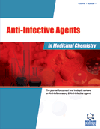- Home
- A-Z Publications
- Anti-Infective Agents in Medicinal Chemistry (Formerly Current Medicinal Chemistry - Anti-Infective Agents)
- Previous Issues
- Volume 5, Issue 1, 2006
Anti-Infective Agents in Medicinal Chemistry (Formerly Current Medicinal Chemistry - Anti-Infective Agents) - Volume 5, Issue 1, 2006
Volume 5, Issue 1, 2006
-
-
Azoles: Mode of Antifungal Action and Resistance Development. Effect of Miconazole on Endogenous Reactive Oxygen Species Production in Candida albicans
More LessThe synthetic class of azole antimycotics constitutes the largest group of antifungal agents currently in clinical use. Widespread use of azoles has led to the rapid development of multiple drug resistance, which poses a major hurdle in antifungal therapy. The generally accepted mode of action of azoles is the inhibition of 14α-lanosterol demethylase, a key enzyme in ergosterol biosynthesis, resulting in depletion of ergosterol an Read More
-
-
-
Pharmacological and Biological Activities of Xanthones
More LessAuthors: Jean Fotie and D. S. BohleThe aim of this review is to collect, systematize and contrast the many recent advances in xanthones' biochemistry and biology. Advances in understanding xanthones' antimicrobial activities will be discussed. Pharmacological and biological properties of naturally occurring as well as synthetic xanthones will be considered in an evaluation of their medical values.
-
-
-
Cationic Surfactants and Lipids as Anti-Infective Agents
More LessAuthors: Ana M. Carmona-Ribeiro, Debora B. Vieira and Nilton LincopanSurfactants in general are well known for their ability of disrupting cell membranes and damaging microbes. However, cationic surfactants and lipids exhibit interesting additional properties because they can easily be targeted to oppositely charged biological structures such as cells or biomolecules of interest. This review emphasizes physicochemical and antimicrobial properties of cationic lipids and surfactants aiming Read More
-
-
-
Use of Anti-Infective Drugs in Rheumatology
More LessThe clinical field of rheumatology utilizes numerous medications which are either structurally derived from antibiotic compounds or are actually originally track - record proven anti - infective agents adapted for use in this field. Though in many cases, exemplified by rheumatoid arthritis, a presumed infectious etiology brought about the introduction of these drugs into rheumatology, subsequent research has often failed to Read More
-
-
-
Mechanisms of Drug Resistance in Malaria: Current and New Challenges
More LessAuthors: P. Cravo, R. Culleton, A. Afonso, I. D. Ferreira and V. E. do RosarioAnti-malarial chemotherapy based on a limited number of drugs has been the mainstay of malaria control for many decades. However, the lack of new effective and affordable drugs and the emergence and spread of drug resistant parasites is seriously hindering treatment strategies, and is contributing to the resurgence of malaria, especially that caused by Plasmodium falciparum. Present knowledge indicates that drug resi Read More
-
-
-
Rationale for Designing of Antigen-Specific Immune Therapy Including Dendritic Cell-Based Therapy in Patients with Chronic Hepatitis B Virus Infection
More LessAuthors: Sk. M. F Akbar, Hidehiro Murakami, Norio Horiike and Morikazu OnjiApproximately 350-400 million people of the world are chronically infected with the hepatitis B virus, and it is these individuals that harbor the virus for their whole life and are responsible for its transmission to uninfected populations. Considerable numbers of chronic hepatitis B virus carriers develop progressive liver diseases like chronic hepatitis B, liver cirrhosis and hepatocellular carcinoma. Current treatments for chronic h Read More
-
-
-
Natural and Synthetic Retinoids: Structural Bases and Biological Effects of Potential Clinical Relevance for the Prevention and Treatment of Infection-Driven Tumors
More LessAuthors: Riccardo Dolcetti, Dario D. Luca and Angel R. de LeraRetinoids play a critical role in the regulation of cell division, growth, differentiation, and proliferation, and represent an exciting new avenue for targeted therapy of different diseases, including cancer. Natural and synthetic retinoids are also endowed with antiviral properties that make these compounds particularly attractive for the prevention and treatment of infection-driven tumors. In this review, we will summarize the str Read More
-
-
-
Recent Developments in Antimalarial Drug Discovery
More LessAuthors: A. A. Joshi and C. L. ViswanathanMalaria with 1 million deaths and about 500 million new cases reported annually is a challenge to drug therapy and discovery. Drug resistance accompanied by lack of progress in the development of vaccines or resistant reversal agents has further aggravated the situation. In this scenario, development of antimalarials acting by novel pathways is the best option. Decoding of the Plasmodium falciparum genome has helped s Read More
-
Most Read This Month
Article
content/journals/aiamc
Journal
10
5
false
en


